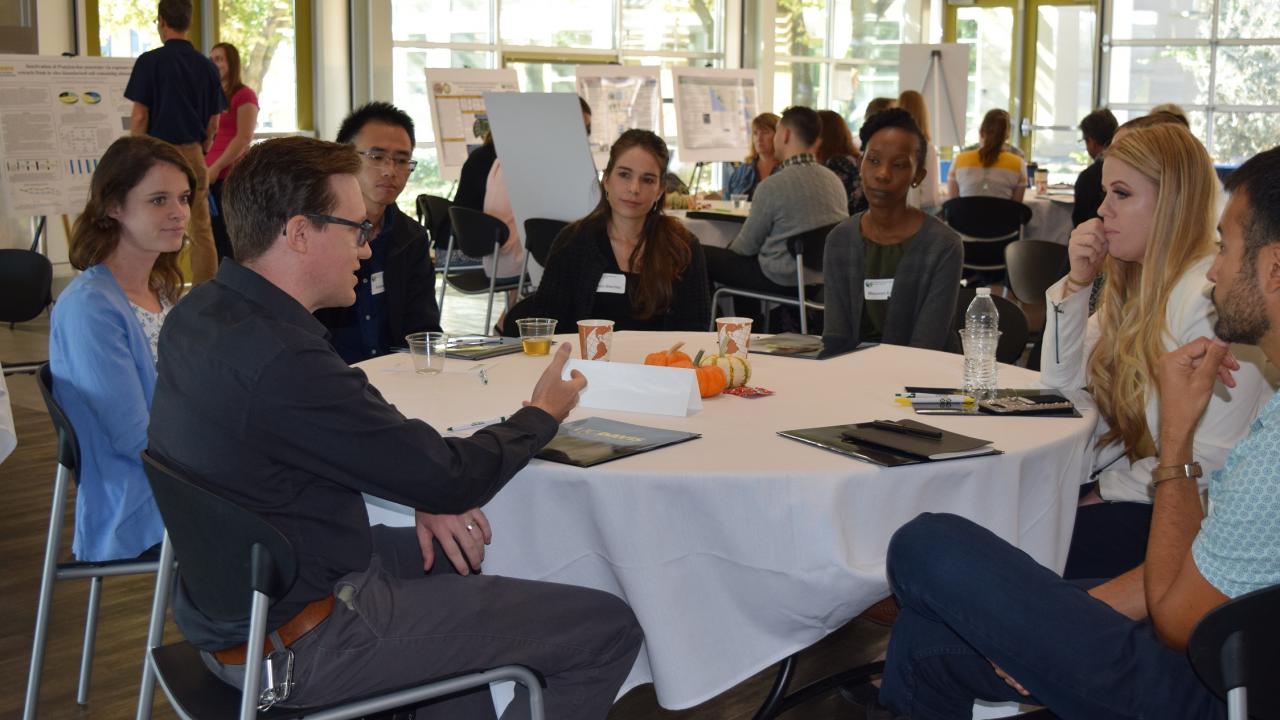
WCAHS Fall Symposium 2017
The Western Center for Agricultural Health and Safety met on October 26th at the UC Davis International Center for their Fall Symposium. The symposium’s theme of diverse approaches to agricultural health and safety was explored through research presentations, posters, and breakout sessions. The goal of the symposium was to bring together multidisciplinary research within the center, to obtain feedback, and to provide opportunities for networking and discussion.
WCAHS Research: From robotics to zoonotics
Five projects make up the WCAHS research core led by leaders from the UC Davis faculty. WCAHS approaches agricultural health and safety from a variety disciplines. Investigators gave a brief presentation of their respective projects, as described below.
Fadi Fathallah, WCAHS Associate Director, and Professor in the Department of Biological and Agricultural Engineering in the College of Engineering and College of Agricultural and Environmental Science presented on his work in developing a mechanical and robotic strawberry harvest aid to optimize workers’ productivity without compromising health effects.
Diane Mitchell presented for the research project led by Marc Schenker, Distinguished Professor in the Department of Public Health Sciences in the School of Medicine. Their project is engaging farmers and supervisors in the development of mobile phone applications (apps) to prevent heat related illness in agricultural workplace.
Kent Pinkerton, WCAHS Director, and Professor in the Department of Pediatrics in the School of Medicine. Dr. Pinkerton, in collaboration with Keith Bein, is assessing the health effects of agricultural air particulates in California with special attention focused on the agricultural Imperial Valley of California and its interface with the Salton Sea.
Rob Atwill, Professor in the Department of Population Health and Reproduction in the School of Veterinary Medicine, is collaborating with the dairy industry to identify and reduce occupational exposure to zoonotic pathogens in dairy farmworkers.
Christopher Simmons, Associate Professor in the Department of Food Sciences in the College of Agricultural and Environmental Science is developing an innovative technique called biosolarization as a potential alternative to soil fumigation and pest control – a common practice with inherent health risks associated with agricultural use of toxic pesticides.
L-R Fadi Fathallah (WCAHS Associate Director), PhD, Diane Mitchell, PhD, Chris Simmons, PhD, Kent Pinkerton, PhD (WCAHS Director). Robert Atwill, PhD
Convening stakeholders
WCAHS sought to attract attendees from UC Davis who have an interest in agricultural health and safety and are not currently engaged with the Center. Of the over 60 symposium attendees, the majority were affiliated with UC Davis, including students, staff, faculty, postdoctoral scholars, and researchers. In addition, individuals affiliated with UC Cooperative Extension, Cal/OSHA, CalEPA, and other stakeholder communities were in attendance. Members of the WCAHS External Advisory Board and Steering Committee also attended.
Breakout Sessions: Cannabis, evaluation, and strategic communication
WCAHS investigators held roundtable breakout sessions with small groups to discuss their research projects in greater depth. The afternoon breakout sessions highlighted the work of the WCAHS outreach core, evaluation core, communication team, as well as several emerging issues being addressed by the Center. Breakout sessions were conducted to foster engagement with symposium attendees and to gain new insights and suggestions. Breakout sessions of particular interest included a discussion of the health and safety risks for workers in the cannabis industry as well as the potential health hazards associated with agricultural practices and the shrinking of the Salton Sea in the Imperial Valley.
A poster session was held to highlight work affiliated with the Center which facilitated networking and open discussion among all attendees. WCAHS funds graduate students on a quarterly basis. The students funded in the 2016-2017 cycle were part of the symposium and the innovative research supported by WCAHS.

Symposium evaluation: Attendees provide feedback
The symposium was highly rated by those who attended. One attendee remarked: “Great day - it was a wonderful opportunity to learn about the research of the center.” Another noted the “excellent diversity in topics being addressed by the Center”. Nearly all l attendees said they would attend a future WCAHS symposium and a majority indicated they would seek future funding from WCAHS research programs.
The symposium provided rich opportunities for networking and collaboration. Attendees were asked to comment on their general experiences during the symposium. One attendee noted, “[The] format of the symposium made it really easy to network and learn more about projects. I think it was a good balance of presentation and highly interactive discussion.” WCAHS will hold its next symposium in October 2018.
